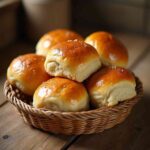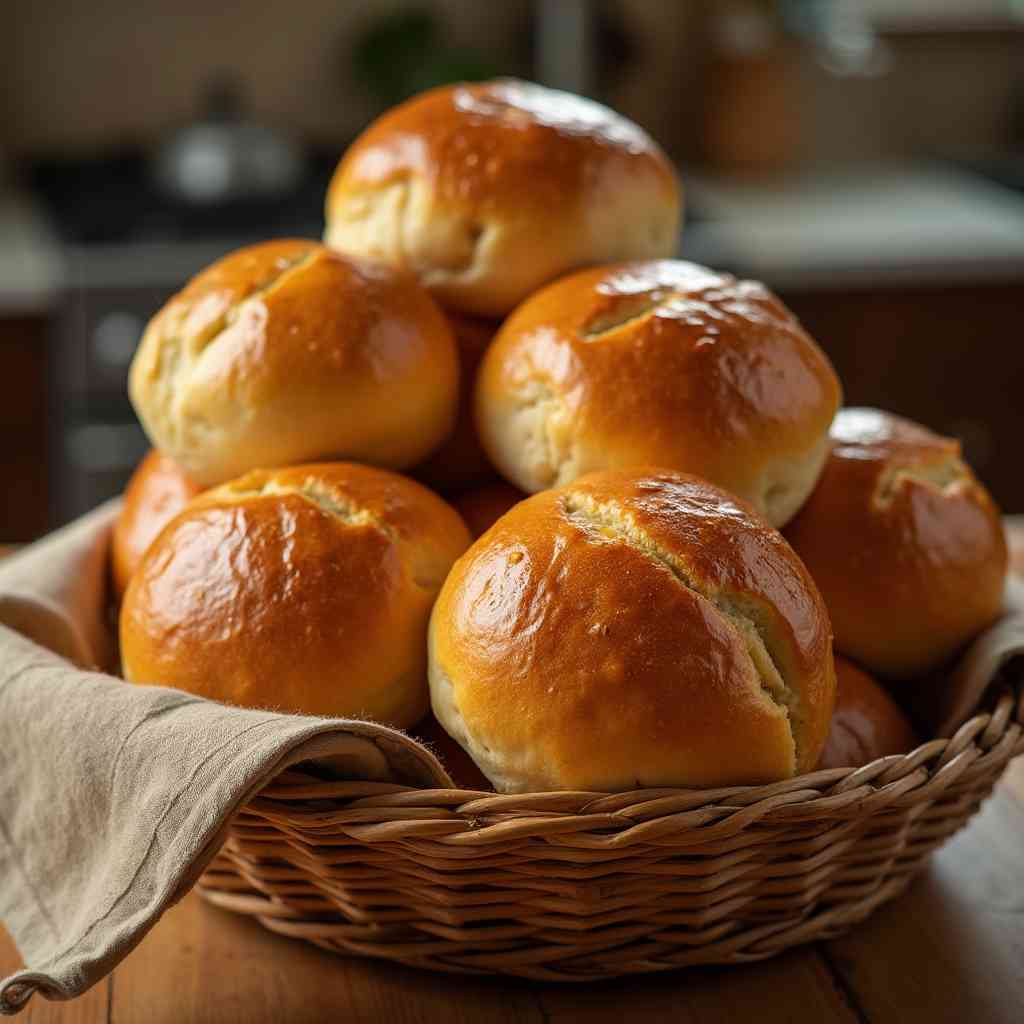Looking for the perfect Hutterite bun recipe? You’re in the right place. These soft, fluffy buns are a staple in traditional Hutterite kitchens known for their rich texture, buttery flavor, and simple, wholesome ingredients.
In this guide, I’ll walk you through the exact steps to recreate these beloved homemade rolls in your own kitchen, along with expert tips, storage advice, and helpful tools to guarantee success. Let’s dive into baking one of the most comforting and timeless recipes around.
Table of Contents
What Makes Hutterite Buns Special?

Hutterite buns stand out because they’re more than just baked dough—they’re a symbol of heritage. These Mennonite-descended communities emphasize communal living, meaning large ovens churn out hundreds of buns every day to feed workers, families, and visitors. The buns are enriched with butter, milk, and eggs, giving them that signature tender crumb and slightly sweet flavor.
Personally, I love how each bite carries a hint of history: these buns connect you to a tradition of sharing and simplicity that’s truly heartwarming.
How to Make Hutterite Buns Step by Step
Before diving into the nitty-gritty details, here’s a bird’s-eye view of the process:
- Activate the Yeast: Get your yeast bubbling in warm water with a touch of sugar.
- Combine Wet Ingredients: Cream together butter, sugar, eggs, and salt.
- Mix and Knead: Add milk, yeast mixture, and flour; knead until dough is smooth.
- First Rise: Let the dough double in size in a warm spot.
- Shape and Second Rise: Form into buns, let them puff up again.
- Bake: Bake until golden brown, then brush with melted butter (optional).

Hutterite Buns
- Total Time: 2 hours 30 minutes
- Yield: 24 buns 1x
Description
Soft, slightly sweet Hutterite buns made with butter, eggs, and milk—perfect for connecting with tradition and feeding a crowd.
Ingredients
- 2 tbsp dry yeast (or 2 packets)
- 1 cup warm water (110°F/43°C)
- 1 tsp sugar (for activating yeast)
- ½ cup softened butter
- ½ cup sugar
- 2 eggs, beaten
- 1 tbsp salt
- 1½ cups warm milk (105°F/40°C)
- 6–6½ cups all-purpose flour
Instructions
- In a small bowl, dissolve yeast and 1 tsp sugar in warm water. Let sit 5–10 minutes until foamy.
- Cream together butter, ½ cup sugar, beaten eggs, and salt in a large bowl.
- Add yeast mixture and warm milk to the bowl. Stir in 4 cups of flour to make a smooth batter.
- Gradually add remaining 2–2½ cups flour until dough is soft and tacky.
- Knead dough for 8–10 minutes by hand or 6 minutes in a stand mixer with dough hook.
- Place dough in an oiled bowl, cover, and let rise 1–1½ hours until doubled.
- Punch down dough, rest 15 minutes. Divide into 24 equal pieces and shape into balls.
- Place buns on greased baking sheets, cover, and let rise 30–45 minutes until puffy.
- Bake at 350°F (175°C) for 15–18 minutes until golden brown.
- Optional: Brush tops with melted butter immediately after baking.
Notes
For best results, use fresh yeast, measure flour carefully, and don’t rush the rise. Brush with butter while hot for extra softness and sheen.
- Prep Time: 30 minutes
- Cook Time: 18 minutes
- Category: Bread
- Method: Baking
- Cuisine: Hutterite
Nutrition
- Serving Size: 1 bun
- Calories: 190
- Sugar: 4g
- Sodium: 190mg
- Fat: 6g
- Saturated Fat: 3.5g
- Unsaturated Fat: 2g
- Trans Fat: 0g
- Carbohydrates: 28g
- Fiber: 1g
- Protein: 4g
- Cholesterol: 30mg
How to Store Hutterite Buns for Freshness
- Short-Term (1–2 Days): Let the buns cool completely, then store them in an airtight container or resealable plastic bag at room temperature. If you anticipate they’ll be eaten within 24 to 48 hours, this is perfect.
- Medium-Term (Up to 1 Week): Place cooled buns in a freezer-safe plastic bag, squeeze out excess air, and freeze. To reheat, thaw at room temperature and warm in a 300°F (150°C) oven for 5–7 minutes.
- Long-Term (Up to 3 Months): Individually wrap each bun in plastic wrap, then place them in a freezer bag. When you want a fresh-tasting bun, unwrap, let thaw, and warm as above.
- Reheating Tip: Sprinkle a few drops of water on the buns before popping them in the oven. This creates steam, reviving that just-baked softness.

More Related Recipes/Articles
If you loved diving into the world of Hutterite baking, you might also enjoy these reads and recipes:
- Explore a comforting Hutterite Sausage Soup Recipe—perfect for chilly evenings.
- Delve into a range of authentic Hutterite Dishes that showcase colony cooking traditions.
- Follow our journey on Old Plain Recipes on Medium for behind-the-scenes stories and recipe experiments.
- Find inspiration and mouthwatering images at Old Plain Recipes on Pinterest.
- Craving something sweet? Try this classic Amish Apple Cake Recipe, another crowd-pleaser.
- Interested in home remedies? Check out this intriguing Amish Amoxicillin Natural Remedy article.
FAQs
Can I substitute milk with water or a dairy-free alternative?
While water can be used, it won’t give you the same richness and tender crumb. For dairy-free options, unsweetened almond milk or oat milk work well—just warm them to the same temperature as you would regular milk.
Why did my buns turn out dense and heavy?
Dense buns often result from over-flouring or under-kneading. Make sure you measure flour correctly—spoon it into the measuring cup and level it off. Also, knead until the dough passes the “windowpane test” (a thin, translucent stretch without tearing).
Can I make the dough ahead of time and refrigerate before the first rise?
Absolutely! After kneading, place the dough in a lightly oiled bowl, cover tightly, and refrigerate overnight. The cold temperature slows yeast activity, allowing flavors to develop. The next morning, let it come to room temperature for about an hour before continuing with the first rise.
What’s the best way to reheat frozen buns?
Remove buns from the freezer and let them thaw at room temperature. Preheat your oven to 300°F (150°C) and warm the buns for 5–7 minutes. For a softer texture, sprinkle a few drops of water on each bun before heating to create steam.


i love this recipe